American Sabbatical 69: 3/12/97
Jamestown
3/12.. Jamestown.
Curious how small details can resurrect forgotten memories. A couple of times in the past
three days a bit of highway has conjured up a footsore teenager
lying his way down these roads. I hitch-hiked from Massachusetts
to New Orleans (actually ended up in Shreveport) my senior year
in high school, and I walked a good part of the way across this
part of Virginia. Each time I got picked up I made up a new story,
my way of amusing myself. Now bits of US1 and 301 make my legs
ache suddenly, and the cars change vintage.
Wednesday AM we tanked up the Owl, who’s still giving us 46-50
MPG depending on highway speeds, and wiggled out into traffic.
We’d decided to forgo all the goodies in the Richmond area (after
all, I’d kissed the wall at the Lucky Strike factory in 1964),
and plunge into the colonial history along the James. Doing triage
on sites of interest is heartbreaking down here, but Peggy had
visited quite a few of them when we lived in Norfolk and Hampton,
so we opted to bypass Williamsburg and Shirley Plantation and
go for Jamestown. But, cruising the sideroad between the Chicahominy
and the James there were simply too many temptations, and we finally
pulled into an antiquarian’s candystore: Berkeley Plantation.
The Owl shuddered over the stony carriage drive leading to this brick mansion along the James River shore, and while Peggy followed the redbrick paths to the requisite movie and tour, I ambled down to the shore. From the steps of the hall I could see the masts of a replica ship, and curiosity got my cat.
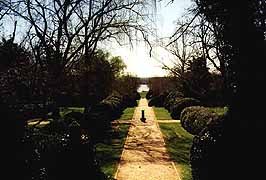
Boxwood Hedges
I zigzagged through the headhigh boxwood hedges and mazes, full
of calling birds this sunny morning. The pissy smell of boxwood
played prank with my ROM, bringing up childhood moments at Windsor
Castle and my mother’s hand in mine. Sweet memories for such a
nasty odor, and you wonder if the colonists planted these ornamentals
precisely because they brought the old country home so vividly.
These plantation sites, like so much of our historic recreation, are mom and pop affairs. They may have national billing, and local association funding, but they are only as effective as the resident owners make them, and priced at what the traffic can bear.
When I got to the shore I was presented with one of those bogus
IT HAPPENED HERE FIRST displays that we so love as a culture.
The FIRST THANKSGIVING. On December 4, 1619 the good ship Margaret
landed here after a stormy passage, and (as instructed by the
proprietors: the Berkeley Corporation) celebrated thanksgiving
to God for their deliverance. There’s a plaque to prove it. And
the recreation of the Margaret is a 2-dimensional mock-up knocked
together out of 2X4s, sagging and ratty with disrepair.
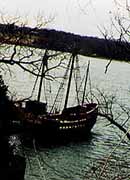
Replica Vessel
The air was full of a familiar buzzing, and going back up the terraces I encountered an angry old black man riding a lawn mower around and around the plantings. Too soon, too soon, a voice was telling me. Not lawn-mowing in March. Maybe there are advantages in a late spring. That aroma was not as nostalgic.
(Memo #59)
Driving in from the west you see the signs for Shirley Plantation
(11 generations of the Hill-Carter clan), Edgewood, Berkeley (Harrisons),
Westover (the Byrds), Evelynton (Ruffins), Belle Aire, Piney Grove,
North Bend, Sherwood Forest (Tylers). These plantations were joined
by an intricate ”web of kinship”, as a guide explained. On this
same peninsula between the James and York Rivers you can tour
colonial Williamsburg, historic Jamestown, and the Yorktown revolutionary
Battlefield. Too many choices for short term touring.
We went to Berkeley, the home of two presidents (William Henry
Harrison and Benjamin Harrison). This is the third Virginia plantation
we’ve visited this trip (along with Mt. Vernon and Gunston Hall
on the Potomac), we’ve seen others in earlier years. We intend
to tour rice and indigo plantations in the Carolinas, and cotton
plantations along the Mississippi to see patterns and variations
in southern plantation life.
Berkeley is reached by a half mile drive on the original carriage
road. Tall trees shade it and surround the brick Georgian mansion.
“Harrison’s Landing” was settled in 1619 by the 38 passengers
on the ship “Margaret” sent by the Berkeley Company of England.
This was also the site of the the first commercial shipyard in
America, of the first corn liquor distillery, and the first American
tobacco warehouses. The Harrison family came in 1691 and Berkeley
was home to two presidents (William Henry and Benjamin). William
Henry Harrison’s Vice-President John Tyler was from just down
the road (Sherwood Forest Plantation) - imagine President and
Vice-President candidates who are neighbors from the same county
running together today.
The current house was built in 1726 for Benjamin IV and his wife
Ann Carter.The Harrison family had provided many colonial, state
and national leaders. (Benjamin V , for example, served in the
Virginia House of Burgesses, was at the First Continental Congress,
signed the Declaration of Independence, and was elected Governor
three times). He also was a classmate and friend of Thomas Jefferson.
Each of the first TEN presidents visited Berkeley! The plantation
claims to be the site of the first Thanksgiving, a ceremony specified
by the Company when the settlers first landed. Taps was composed
here when it was headquarters for the Army of the Potomac (140,000
men) in the Civil War. Unbelievably, the current 88 year old owner
is SON of a drummer boy for General McClelland (who had children
late in life)! This makes the Civil War seen recent.
The great house and gardens are beautiful. Five garden levels
with lovely steps between them drop to a long lawn leading down
to the river. I wandered among boxwood hedges, brick walks, flower
gardens, stone seats and balustrades. The basement is now a small
exhibit space and theater. I saw an introductory film and then
toured the first floor.
The tour gave many facts about the Harrison family, colonial architecture
and furniture, and the reconstruction work of the current owners.
Inheritance and property taxes are a major burden. To support
Berkeley, the current owners have started a successful boxwood
nursery business, cafe, and they rent out apartments in many of
the plantation’s outbuildings, the "dependencies" (so they are
not on the tour). The tour shows the work to restore the mansion,
it did NOT give a fully picture of plantation life or the dozens
of people who worked there.
At its height, Berkeley encompassed 8000 acres and had 100 slaves.
The primary cash crop was tobacco. The mansion has America’s first
pediment roof. The brick walls took five years to make and are
over two feet thick. The floor plan is similar to many great houses
of the period, a large central hall (used here as a ballroom),
with two large rooms off each side. There are two chimneys, and
four fireplaces. The architects strove for balance, every doorway
had its partner (one is a blank, just for effect). Each room has
interior wooden shutters that fold into the walls.
The guide (whose mother-in-law actually attended a ball here in
her youth) gave fascinating details. The gorgeous wooden secretaries
have 12 drawers (for monthly accounts), 4 larger drawers (for
quarterly accounts), and special hidden drawers (a wig drawer
with mirror, for example). There is often a dogwood flower detail
in the wood carving. A neat explanation was given for the ball
and claw foot found on so many colonial pieces. It apparently
derives from China and is a dragon clutching the pearl of wisdom.
Once again historical representation is an issue. Furnishings
were sold off or looted and the mansion was sold by the Harrison
family. The current owners have lovingly furnished the mansion
with "period furnishings", although few of the pieces belonged
to the Harrison family. No outbuildings are available for touring.
Plantation life is really not presented. This was a tour of a
beautiful old house, inhabited once by an illustrious family.
Maybe that’s enough.
3/12.. cont.
After Peggy escaped from the full family treatment, we swung back onto the byroad.
Immediately a state trooper hung a U-ey and proceeded to follow
us to the county line, dropping back behind the curves periodically,
then pushing up close. We probably are an oddity. The historic
places are full of kids in yellow buses and the elderly in Camrys.
Hairballs in Festivas with owl masks in the window probably make
John Law’s backhairs go straight up. But he wasn’t hot enough
to bust me for our broken tail-light, and we crossed the Chicahominy
into James City County. Outlaws on the run.
The river roads down here in the tidewater run through aisles
of tall pines with scrub underbrush, or dense groves of 100-foot
hardwoods festooned with Tarzan vines. The red flash of cardinals
punctuates the somber woods, and the roadside margins are showing
their pastel lingerie. At Jamestown they were tarring the parking
lot, and another romantic scent filled the air. While Peggy went
to look for Capt. Smith and Pocahontas, I went in quest of a used
book store, hoping to find a copy of The Great Rogue, or at least a couple of potboilers for one of us to read while
the other putes. Fighting over this keyboard can get intense some
nights.
The Great Rogue is a bio of Capt. John written in the 1950’s, and an astonishing
yarn. He was only 26 when he talked his way into the Virginia
Company’s lists, and already had a decade as a soldier of fortune
behind him. He had the reputation for being one of history’s great
liars, having spent his later years as the New World’s number
one promoter (he coined the name “New England” as a come-on to
the unsuspecting). So historians were loath to credit all the
brags in his autobiography.. like debating the Jesuits on theological
matters, inventing a primitive anti-personnel weapon in a Transylvanian
battle, rescuing an enslaved English woman from a Moroccan harem,
being a member of a pirate crew in the Adriatic, or besting three
Turkish champions in mano-a-mano fights for the fate of a Balkan
city. The scholars were rudely jolted when documentary evidence
began surfacing to support these wild tales.
Not that the Capt. is to be trusted. The Pocahontas story didn’t
appear in his accounts of the Virginia Colony until the third
edition, at which time the lady in question, now married to John
Rolfe, was the toast of the town in London, a favorite of the
Queen, and a tasty fillip to boost book sales (can’t you see the
lurid cover now: naked Indian maiden throws herself over heroic
Englishman’s neck?). Historians have found the story of her rescuing
a colonist from her father’s fury in the diary account of another
young man, which account Smith had copped. In any case, The Great
Rogue wasn’t in the stalls, but I got lost among the fulminations
of Artemis Ward and other 19th century humorists. Isn’t it strange
how little of what passes for humor in one age gets ruled incomplete
in the next? Dialect jokes fall on deaf ears after only a few
decades. You had to be there, I guess. Jeesum.
(Memo #60)
March 12 Jamestown
Who? settlers sent by the London Company
What? first successful English colony in the New World
Where? swampy island up the James River
When? 1607
How? funded by a London-based corporation
Topics: colonial settlement, Jamestown settlement, the Starving
Time
Questions: How did Jamestown succeed?
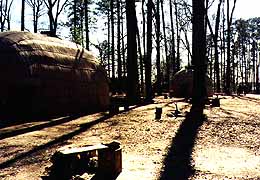
Jamestown Replicas
It’s hard to choose places to visit on the peninsula. Westover?
Sherwood Forest? Yorktown? Williamsburg? Jamestown? I chose the
last for several reasons - I hadn’t toured it the last time through,
I’m fascinated by parts of the story (the gentlemen settlers of
Jamestown who wouldn’t to do hand labor, Pocahontas, incredible
Captain John Smith), and Norm Buttrick does so much with colonial
archaeology at Freeport High, using Ivor Noel Hume’s books (from
his work at Jamestown)!
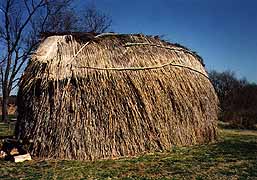
Indian Housing
Well.... Jamestown has a HUGE museum, and - outdoors - a recreated
Native American camp, a recreated fort enclosing thatched cottages,
a church, store houses, and two ship replicas. All are found together
within a five minute walk on the bank of the James. It is a good
mile from the original site of the first settlement.
The museum had at least ten rooms which give a thorough treatment
of life in England at the time, the trip over and the difficulties
of navigation in the early 1600s, the culture of the native Americans
in the area, the life at Jamestown. The museum seemed too long
on text, but there were some nice displays. Text and charts showed
the classes and huge poverty in England in the early 1600s, the
primacy of handwoven textiles in the economy, the motives for
emigration. There was a good display on the crop that saved Jamestown:
tobacco (the species nicotiana tabacum was not native - the seeds
came from the Spanish). Tobacco was an instant fad in England.
I really liked the gallery on Native American / First Peoples
life. Pressing a button gave you a Lenape language dialogue. A
display showed hunting and fishing techniques and another the
foods, on dishes, laid out by seasons (the Native Americans used
plants ranging from persimmons to flagroot and Chickasaw plum).
Contemporary English boatbuilding techniques were shown with a
quarter scale half model in one place, another showed house construction
methods used at Jamestown (wattle & daub houses, thatched roofs).
New World prehistory and history were shown on a time line with
period specific artifacts.
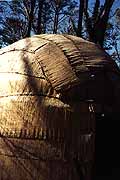
Mat Siding
There were 32 tribes in the area united under the Powhatan (supreme
leader - a man called Wahunsonacock). These tribes lived in villages
of about 100 people. There were different ranks of society (priests,
warriors, rulers) and matrilineal inheritance (through the mother’s
blood line). The hunting-gathering economy exploited a wide range
of plants and animals with the whitetailed deer at the center.
There was an extensive trade network in copper, shells-pearls,
pipestone.
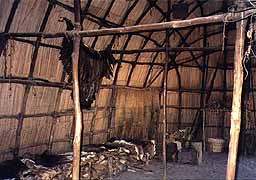
Interior
One room tells the story of Pocahontas (Matoaka). It has a copy
of the one portrait made during her lifetime and a number of romanticized
depictions of the Indian princess who “saved” John Smith. Alas,
no room is allotted to John Smith, one of history’s most interesting
soldiers of fortune - HIS life should be a Disney feature.
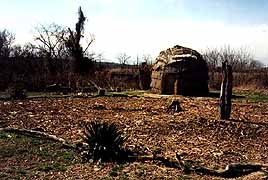
Indian Town
The museum ends at the doors to the outdoor recreations. You can
see Native American village / fort / ships in one glance. Well-maintained
paths lead around it all. There are frequent labels to explain
the structures. I liked the Native American dwellings, huge quonset
huts made of reed mats over arched boughs. The interiors seemed
authentic with animal robes on low platforms, open fires, storage
vessels. Buckskinned interpreters were scraping hides and pounding
food outside. There was a small Native American garden.
The triangular fort is constructed according to the original records.
There are small houses, a church, store houses within. Each was
furnished with facsimile artifacts. The ships are moored to a
stout wharf. There are costumed interpreters throughout. Some
worked at tasks like woodcutting. They answered any questions.
Tourists can try on helmets and armor, sit at woodworker’s benches,
watch a blacksmith.
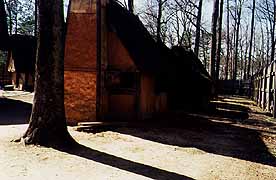
Colonial Street
It was all very neat and tidy, designed for easy access by scores
of tourists.
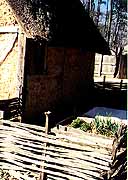
Kitchen Garden
Jamestown is a major big time tourist site. Even on the off season
there were scores of schoolchildren in groups, and families and
couples. Every picture I tried to take had 1997 folks in it so
it is hard to get a sense of history. I felt a little let down
as I did several years ago at Sturbridge.
Hundreds of thousands of tourists a year see this site. What do
they see? It seems an edited sanitized abbreviated view of the
1607 colony - no mud, no smells, no “necessaries” ( the word for
outhouse used at the plantations). The costumes were clean, the
interpreters well-scrubbed and using 1997 language. Like beautiful
Berkeley plantation where I saw four gorgeous period rooms, Jamestown
gave me a partial (romantic?) interpretation
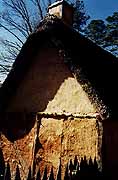
Wattle & Daub
I suppose the visitors do get details (the look of wattle and
daub, the heft of armor, the amount of poverty in Elizabeth’s
England). If they read all the museum text they learn a lot. But..........
has success damaged Jamestown and Sturbridge?
Canada has just stopped providing government funds for historical
recreations because the builders can never get it right. Can we
ever reproduce or experience the past?
3/12.. concluded.
Then it was down the last finger to nostalgic Norfolk. You can guess which finger (this is a Navy
town). I didn’t recognize a thing. These flatland seaports are
utterly lacking in charm: Newport News, Hampton, NorVa. Jungles
of towering cranes, acres of tank towns, miles of coal cars (I
used to cycle down to the Norfolk and Western coal docks to watch
the big machines pick up the railroad cars and dump the coal into
ships), concrete, chainlink, rows of onestory brick and ciderblock
bungalows, bluff and bland institutional piles.. totally unmemorable.
Peggy insisted we drive around Hampton University (nee Institute),
where she had her first college teaching job. Still an almost
totally black school (one white ROTC officer in evidence), and
Peggy remarked again how comfortable it must be for blacks to
go to school here, with none of those cross-cultural games. The
place still looks unembellished, a place where scholarship is
more important than posturing.. although the black recruits were
ramrod straight. Maybe it’s the military flavor of the area.
Through the tunnel (where Peggy once had a flat, and got the quickest
emergency road service in her life), and into the town where she
learned how to drive. It’s a wonder she did. As I recall Terry
Evans and I would get in the back seat of our VW wagon with a
six-pack, and shout instructions at her through gales of laughter,
spilling ourselves foolish when she popped the clutch or stalled.
Maybe that’s why Owlriding seems like a lark to her now. SHE remembered
all the turns this time, and directed us downtown to Redgate Avenue.
Norfolk IS remarkably forgettable, and but for a new section of
securely-fenced condo clusters in Ghent, just the way I didn’t
remember it. The first home we made together was in a turn of
the century pile on Redgate, just up a little park from the Ghent
Canal in the one neighborhood with some period charm, and we had
good times there making a marriage, some terrible furniture, and
some lasting friendships (two of the e-riders in the Owl’s backseat
are friends from those days). But we only had eyes for each other
I guess, cause I was lost within a block. I could still find my
way blindfolded around the communications software I designed
for those monstrous old third generation computers at CINCLANTFLT,
but put me on Grandby or Colley Ave, and I’m lost.
We mooned over our old digs for at least 30 seconds, and then
remembered why we had hustled out of Norva way back when. How
many of the early colonists blessed the day they set foot back
on Blighty’s beach? One summer in tidewater would convince you
that the Indians should have fought just a little bit harder.
Look what happened to Pocahontas.. took sick and died in crinolines
and lace.
We made it as far as Chesapeake before reporting for night duty
at Super8.